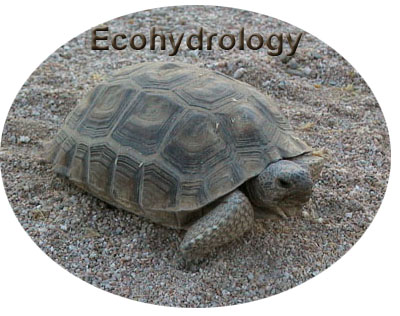

Water quality and availability are major determining factors of ecosystem health. Likewise, ecosystems have a dominating influence on water resources—notably in the interactive biota and geologic systems that constitute an ecosystem are essential to the hydrologic cycling that sustains the supply and maintains the quality of accessible water.
In arid and semiarid regions, plants and animals use different strategies to survive and flourish with minimally and erratically available water. The depth to which infiltration percolates and the degree to which water is retained at particular depths are critical to the favorability of a given site for particular plants, and their ability to survive drought.
Areas of research in ecohydrology include soil moisture availability, transpiration and plant water use, adaption of organisms to withstand drought, influence of vegetation on stream flow and function, and feedbacks between ecological processes and the hydrological cycle.
Highlights:
In the Mojave National Preserve, California, we conducted field studies and numerical modeling that demonstrated how certain features of
natural soils enable plants to access available water during long intervals without precipitation.
Nimmo, J.R., Perkins, K.S., Schmidt, K.M., Miller, D.M., Stock, J.D., and Singha, K., 2009, Hydrologic Characterization of Desert Soils with Varying Degrees of Pedogenesis -- I. Field Experiments Evaluating Plant-Relevant Soil-Water Behavior: Vadose Zone Journal, v. 8, no. 2, p. 480–495. (PDF) Mirus, B.B., Perkins, K.S., Nimmo, J.R., and Singha, K., 2009, Hydrologic Characterization of Desert Soils with Varying Degrees of Pedogenesis -- II. Inverse Modeling for Unsaturated Hydraulic Properties: Vadose Zone Journal, v. 8, no. 2, p. 496–509. (PDF)
Our investigation of effects of reforestation on soil moisture dynamics and aquifer recharge at the Auwahi site in Hawaii has discovered important facts concerning the role of the
underlying soils, and of land use, in regulating water flow through a complex ecosystem Our investigation of effects of reforestation on soil moisture dynamics and aquifer recharge at the
Auwahi site in Hawaii has produced understanding of the role of the underlying soils, and of land use, in regulating water flow through a complex ecosystem
Perkins, K. S., Nimmo, J.R., and Medeiros, A.C., 2012, Effects of native forest restoration on soil hydraulic properties, Auwahi, Maui, Hawaiian Islands: Geophysical Research Letters, 39:L05405 doi:10.1029/2012GL051120. (PDF) Perkins, K.S., Nimmo, J.R., Medeiros, A.C., Szutu, D.J., and von Allmen, E., 2014, Assessing effects of native forest restoration on soils moisture dynamics and potential aquifer recharge, Auwahi, Maui, Ecohydrology, DOI:10.1002/eco1469. (PDF)
Over 15 years, reintroduced native plants have significantly altered the soil hydrologic properties.
During infiltration in grassland dominated by invasive species, water movement slowed with depth whereas at reforested locations, water movement was rapid through the entire uppermost meter of soil.
The observed changes act in the direction of faster and deeper distribution of infiltrated water, as appropriate for native plant needs.
Through interpretation of archival documents and new experiments, extended and published Lyman Briggs’ unfinished 1950s study of the hydromechanics of pollen-dispersal processes.
Nimmo, J.R., Hermann, P.M., Kirkham, M.B., and Landa, E.R., 2014, Pollen Dispersal by Catapult—Experiments of Lyman J. Briggs on the Flower of Mountain Laurel: Physics in Perspective, v. 16, no. 3. (PDF) (Appendix material available here)